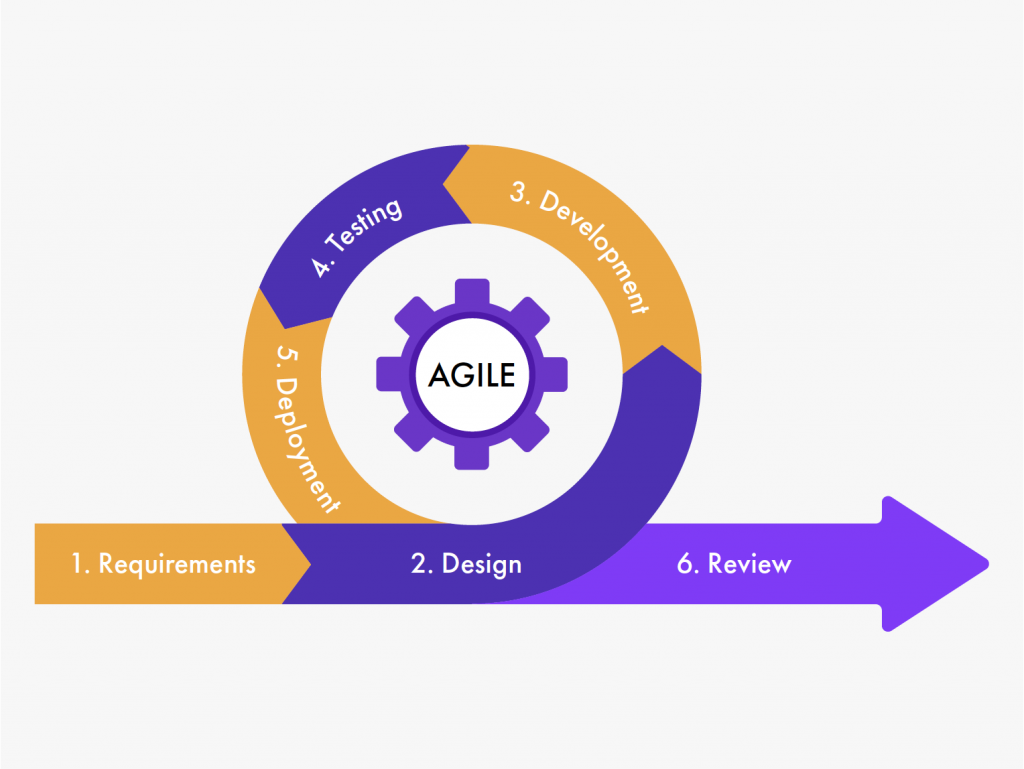The Perfect Combination - DevOps and Agile Methodology
Join our community who have learnt how to deploy technology faster and have been enabled to disrupt their sector to deliver better customer service and growth.

Introduction
The pandemic has given rise to a new world, and demand for advancements in technologies to facilitate business efficiency, control and growth has been significant. The technology industry is moving at its fastest pace in history to meet that demand. To be successful in today’s world businesses need to keep up with the change in customer needs and habits. To deliver the highest quality technology solutions, clients need a very strong development strategy and process to deliver the necessary change.
What is the best software development strategy in the technology sector? What combination will deliver maximum benefit to your clients and match customer expectations and demands?
The answer is a DevOps / Agile development methodology.
Sprint Implementation combined with DevOps / Agile development methodology provides organisations with the combination required for an efficient and successful development process.

What is Agile Development Methodology?
There was a time when the Waterfall methodology was considered the gold standard of developing software. This methodology had several limitations and drawbacks as such it required a lot of documentation before any coding practically started. The Agile methodology replaced the waterfall methodology soon after it was formally launched in 2001and the development of the DevOps culture in 2007combines agile practices of software development (Dev) and IT operations (Ops). With the aim to shorten the systems development life cycle and provide continuous delivery with high software quality. DevOps is complementary with Agile software development; several DevOps aspects came from the Agile.

What Are The 12 Principles of Agile Project Management?
The highest priority should always be client satisfaction through earliest and continues delivery of beneficial software.
All changes, early or late in the project should be welcomed. Agile processes are equipped to handle change to give the customers a competitive advantage.
- Delivering working software in a shorter time frame ranging from a couple of weeks to a couple of months. The timescale should be as short as possible.
- Developers, project owners and other related people should be in constant communication throughout the project.
- Are your employees motivated? Provide with an environment which helps them flourish and enhances the overall performance.
- The most effective mode of communication is face-to-face communication. Information transfer should be made very clear and effective.
- The primary measure of success is the working software.
- For sustainable development, the Agile processes are very important. The developers, sponsors, manager, and users should maintain a constant pace throughout the development process.
- Technical excellence and a great design in the key to enhancing agility.
- Simplicity in all processes is very important to maximize productivity of the amount of work that needs to be done.
- Self-organising teams create the best designs, requirements, and architectures.
- The teams should produce ideas to increase productivity at a regular basis and then the most effective ideas should be implemented among the teams.
Discover What We Do

What is the Software Development Process?
Agile methodology always starts with defining the roles and users. This is followed by the documentation of a vision statement including the scope of the problems that might arise during the development process, the opportunities that may present themselves and the value that needs to be addressed. Once the needs of the customer are captured and the strategy and vision are created it is the project owner’s responsibility to capture the vision and work with the software development team or multiple teams to deliver the resulting technological change. The key to success is constant communication among the team members and the project owner. The roles in the DevOps / Agile culture and the development process include:
Users
The Agile development process always starts with keeping in mind the users or customers. The customers’ needs and behaviours are considered while designing the workflow of the software. Understanding the users always leads to a successful delivery and a quality solution.
What is the role of the Product Owner in DevOps?
There is a need for a person who can be the voice of the customer. Their responsibility is to create a product vision that meets the clients needs. This person is called the product owner. The product owner needs to filter all the insights, feedback, and ideas to create a product vision which is simple and straight forward. The product owner works with the development team breaking down the product vision into smaller user stories. These user stories help developers understand the problem that needs to be solved and why it is important for the client. The constraints and limitations are also put forward. The product owner makes sure that the development team understands the requirements and the necessitating solution. It is very important for the development team and the product owner to completely understand each other the DevOps culture inspires collaboration and ensures teams are aligned.
What does an Agile/DevOps development team look like?
The teams in DevOps / Agile development usually consists of a diverse group of people with the desired mix of skill sets as well as the desire to work collaboratively to get the job done efficiently and to the correct standard. The main focus is on delivering the highest quality software in the minimum possible time. The multi-disciplinary team members focus on delivering working software like databases, business logic and the user interfaces are created and demoed individually.
In this methodology we do not have to wait for the whole application to be developed to make bug fixes and resolve problems. To avoid any unseen problems and cost team members need to be in constant communication, time zone cross over allows for 24/7 collaboration and development which maximises output.
Effective communication is managed by constant collaboration and report submissions to make sure that everyone is aligned in the delivery of the solution. New ideas and suggestions are gathered and if a new idea is approved the teams adjust roadmap accordingly which increase productivity.
There are other roles in the DevOps Agile culture and development process depending on the types of software that needs to be developed. The software quality teams may include scrum masters, UI/UX designers, data base engineers, software quality engineers.
Why choose a DevOps / Agile Methodology?
The main reason the DevOps / Agile methodology stands out among all other methodologies is its flexibility and adaptability. We do not need to design and address all the problems and requirements up front. In a DevOps / Agile environment the issues are divided into smaller problems and dealt with one at a time by the relevant individual or team. If there is a change in requirements other methodologies do not have the ability to adapt as quickly remember demand has created the DevOps / Agile methodology or culture which means we can deliver consistently at speed according to the new needs and requirements of the market. In a DevOps / Agile culture, we can change the requirements of the project at any time, as we do not have to wait for the project to be delivered before review, as testing is an ongoing part of the process. If there is a problem that arises during the development phase in a DevOps / Agile methodology we can adapt and change so that the problem is dealt with at speed, and future bigger issues will be avoided. In a DevOps / Agile culture or methodology every team member collaborates and contributes to the solution It also makes sure that each and every person takes responsibility for his or her work which leads to an increase in code quality.
What is Sprint Implementation in a DevOps / Agile Environment?
The word sprint is when a person runs at his fastest face to finish in the shortest period of time. Similarly, sprint in DevOps / agile is an element of the final iteration in which we develop part of the solution in a short period of time. Sprints usually last from a week to a month, but should not last any longer or the sprint becomes too complicated. Sprints are the core of DevOps / Agile development methodology. A complex development process is divided into many iterations of the solution, and we deal with one iteration at a time. The three main characteristics of a sprint are:
It maintains a constant delivery cycle throughout the complete software development process.
A new sprint starts immediately after a previous sprint is concluded.
The start and the end date of the sprint is pre-arranged.
Sprints are necessary in the DevOps / Agile development process because software can be very complicated making the development process very complex. Every piece of the solution goes through the sprint process. It covers an entire workflow of the sprints. The sprint process breaks down into simpler steps and the requirements are usually provided the by the users of the solution by working with our strategy and consulting team the requirements are designed to meet the exact needs of the users. A simple sprint might look something like this:

What is the DevOps / Agile Sprint Cycle?
The Agile sprint cycle is the process which is used by developers to tackle a big software development process. The steps are usually repetitive with various numbers of sprints depending on the complexity of the project. There can be different types of agile sprint cycles, but they can generally be defined by the following steps:
- Planning:
The team prioritises the tasks and decides what they can / cannot deliver within the sprint. The team also decides what tasks are needed to be completed in order to complete the sprint. - Backlog:
This is the list which is finalised in the planning phase. It is agreed by the whole team collaboratively. It defines the tasks of the development team and identifies what will be completed during the sprint. The backlog includes all the tasks need to be completed together with any possible changes that might be needed during testing. - The Sprint:
This is the time frame that is decided. The actual development work is done during this period. Generally, our sprints last around 2 weeks. But they should not exceed 30 days. Daily Scrum:
The scrum is a daily short meeting which is led by the scrum master. The teams come together to talk about the assignments they are working on, and the progress and the milestones achieved. The teams talk about the obstacles they face and the optimum solution to these obstacles.The scrum is a daily short meeting which is led by the scrum master. The teams come together to talk about the assignments they are working on, and the progress and the milestones achieved. The teams talk about the obstacles they face and the optimum solution to these obstacles.
- Outcome:
This is the result of the sprint. A product is created which is usable. The clients get to decide if the element that is created in that sprint is usable or if there are any more changes that need to be added to the solution. - Sprint End:
To conclude the sprint the teams get together for 2 final collaborative meetings. The first is the sprint review in which the teams present the element completed in that sprint to the product owner. The sprint is not concluded until the product owner approves the solution. The second meeting is usually a self-evaluation meeting. Teams discuss the obstacles they faced during the sprint and give suggestions to improve the sprint in the future.

What are the Benefits of Sprint?
The real question is how is sprint in DevOps / Agile development going to benefit your organisation? Here is a list of benefits that sprint implementation:
- Cost effectiveness: Once the project is divided into sprints the development team no longer needs to guess the budget of the development project.
- Smaller timescales allow the teams to effectively predict the budget for the project and allows the teams to utilise the budget properly thus saving cost.
- Flexibility/Agility: In some cases, the clients’ requirements change with time, and they might want to add or remove a new feature. The agile development process allows the teams to respond quickly to changes in the project.
- High Quality: The quality of the product in sprint agile development is higher than other methodology because the teams perform rigorous testing in each sprint. Instead of creating the complete project and then testing it, sprint agile development allows the teams to test at every process at every stage. Every component is tested individually and finally as the whole solution.
Transparency
There is constant collaboration and communication between the stake holders, product owners and the team members. This means that there are no surprises for product owner, and they can easily make corrections at every step of the development process rather than wait for the project to complete and then realise the solution does not meet it’s requirements. It also helps with team performance, motivation and ownership of the solution and if any team member is not performing as desired, they can easily be identified. It encourages team members to over perform and form a high performance, highly motivated team.
Lower Risk: The project is divided into sprint which makes it easier to identify any issues or risks on an ongoing basis and allows the development teams to deal with any problems as they arise. Sprints prevent the whole project from failing because each sprint is approved by the product owner. The incremental progress mitigates the risk of failure.
- Better customer satisfaction: The transparency, constant collaboration and communication between the clients and the development team allow the customer to have a firm understanding of the progress that is being made. This increases customer satisfaction as there are no surprises for the clients. There is no chance of miscommunication and when the project is completed it meets the needs of customers and satisfies the need for the project in first instance.
- Increased revenue: Sprints produce releasable increments of a project which can be used to generate revenue on an ongoing basis. The sprints are so efficient that the product can go to market sooner generating more revenue quickly.
- Early market availability: In today’s competitive and fast-moving environment releasing your solutions before your competition can create significant competitive advantage. Sprints in a DevOps / agile development process makes this possible and allows the solution to maintain its highest code quality and still be delivered in minimum time.
- Higher Team morale: The agile development methodology allows team to come together and share their progress and success. As the project progresses it builds team morale. Constant encouragement and achieving milestones encourage the team members to perform even better. Constant communication also allows members to identify team weaknesses and obstacles so that they can learn and improve to increase productivity.

In Summary: What is Global Agile development?
In today’s world software companies are creating software solutions that are developed by globally teams in the cloud. It’s very common and beneficial to speed of output that different team members work in different time zones.
It can yield more benefits and fewer complications. In the sprints each team member has well defined roles and communication has been made simple through different collaboration tools or cloud-based applications. Technology enables constant communication between team members and with the project owners makes it possible to operate with a global team.
Each team knows each other’s individual skill set and can call on their expertise as necessary to meet their responsibilities and deliver projects. They can work and perform their duties from any-where in the world and at any time. Regular scrum meetings ensure that no one is downtime, and every member is held accountable for delivery. If any issues arise, they can be managed immediately.
Incremental progress also allows the clients to monitor the progress of the project and recommend any changes that might be necessary through shifts in market demand. Operating through time zone cross over reduces the time of development to this end there can be significant cost savings as well as the obvious speed to market.
A well-managed DevOps / Agile culture delivers huge benefits and ultimately drives success and significant customer satisfaction that leads to a companies’ growth.
DevOps /Agile culture is very popular all around the world, it has been adopted by almost every technology organisation but not many operate the methodology with time-zone cross over to maximise the benefit to clients and users. There is no doubt about the effectiveness of DevOps / agile development as no other methodology produces as successful results when compared to DevOps / agile. In the new world change is occurring in business at a much faster pace certainly when compared to pre-pandemic times.
DevOps / Agile methodology and culture provides the most effective results for organisations. It helps them develop and implement change at speed. At Neo Technology we believe we are a at the cutting edge of technology and Software development with time-zone cross over and can maximise returns for clients over and above the rest of the industry.
Maybe after reading this document, you want connect with us and reach out and reap the benefits of our operations. https://calendly.com/meetwithstu